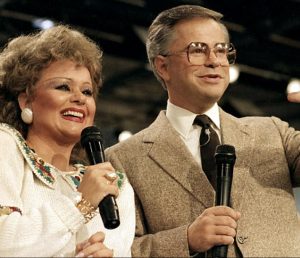A common complaint of liberal mainline clergy during the 1960s was that while their parishioners heard them on Sunday, every other day of the week they listened to conservative religious broadcasters. That habit contributed to the exodus of many church-goers from mainline denominations into evangelical churches over the next several decades, a trend that evangelicals celebrated.
By the 1980s the tables had turned: a new generation of broadcasting personalities competed for the hearts and minds of evangelical parishioners. Many of these broadcasters promoted a variant of Pentecostal theology called the “prosperity gospel,” which promised believers that God would reward their faith—especially their faithful donations—with material blessing. Other evangelical clergy criticized the prosperity gospel for reducing God to a divine ATM machine. But the prosperity preachers quickly became the most influential voices in American religion, attracting millions of adherents who donated billions of dollars annually.
John Wigger’s new biography, PTL: The Rise and Fall of Jim and Tammy Faye Bakker’s Evangelical Empire, covers two of the most prominent of these televangelists, Jim and Tammy Faye Bakker. Wigger’s previous book about Francis Asbury was titled American Saint; this book could’ve been titled American Sinner. Wigger—a professor of history at the University of Missouri—conducted interviews with several of Jim Bakker’s key lieutenants, endured countless hours watching The PTL Club tapes, and dug up the extensive court documents from Jim Bakker’s various criminal and civil trials.
Wigger’s sparkling prose makes the book a joy to read, even if at times his humorous asides say more about the author than about his subjects. For example, Wigger struggles to see how a particular young woman, who chanced on a card bearing 1 John 4:16, “He that dwelleth in love dwelleth in God, for God is love,” interpreted it as a sign that she should marry her suitor, an itinerant evangelist (110). That minor criticism aside, Wigger’s book is a necessary addition to the bookshelves of those interested in American religious history.
Prosperity of the Prosperity Gospel
Nothing about Jim or Tammy Faye Bakker’s upbringing—working-class families, college dropouts, small-time Pentecostal evangelism—suggested the heights to which they would rise. But they combined a charismatic stage presence with a message of growth and prosperity that appealed to the consumer mindset of the 1970s and 1980s. It’s not hard to see the attraction in a message proclaiming that since God delights in rewarding his children, “when you want a new car, just claim it . . . and be sure to specify what options and what color you want too!” (6).
Bakker’s theology wasn’t novel; he was the inheritor of a lengthy tradition of preachers, from Aimee Semple McPherson to Norman Vincent Peale, who emphasized God’s desire for our prosperity, health, and spiritual wellness. Indeed, Norman Vincent Peale was one of Bakker’s first guests when he started his television program. Other prosperity preachers like Robert Schuller also made regular appearances.
But it’d be a mistake to confine Bakker to that corner of the evangelical ecosphere. No less a mainstream figure than Billy Graham once came on Bakker’s show, telling him, “I watch you so often, my goodness, I feel like I’m part of your family” (138). Bakker would later return the favor by buying Graham’s childhood home and moving it to his ministry complex in what Wigger calls an attempt “to buy authenticity” among evangelicals (136). And for a brief period, discussed later, Jerry Falwell temporarily filled in for Bakker during the latter’s legal troubles.
As a young man, Bakker asked the evangelist who mentored him, “What’s the key to success as an evangelist?” The response: “Results” (23). By that measure, the Bakkers were successful evangelists indeed. They started with a puppet show for kids on Pat Robertson’s Christian Broadcasting Network in 1965, but Jim eventually had the idea of starting a talk show for Christians modeled after Johnny Carson’s popular variety show. The result was Robertson’s highly successful 700 Club. After a falling out with Robertson and a brief sojourn in Los Angeles helping Paul and Jan Crouch start what would become Trinity Broadcasting Network, Jim and Tammy Faye moved to Charlotte, North Carolina, in 1976 to launch their own talk show, The PTL Club (for “Praise the Lord”).

PTL: The Rise and Fall of Jim and Tammy Faye Bakker's Evangelical Empire
John Wigger
PTL: The Rise and Fall of Jim and Tammy Faye Bakker's Evangelical Empire
John Wigger
PTL is more than just the spectacular story of the rise and fall of the Bakkers. John Wigger traces their lives from humble beginnings to wealth, fame, and eventual disgrace. At its core, PTL is the story of a group of people committed to religious innovation, who pushed the boundaries of evangelical religion’s engagement with American culture.
Drawing on trial transcripts, videotapes, newspaper articles, and interviews with key insiders, dissidents, and lawyers, Wigger reveals the power of religion to redirect American culture. This is the story of a grand vision gone wrong, of the power of big religion in American life and its limits.
Jim Bakker personifies much about the last four decades of American evangelicalism.
The Bakkers proved adept at growing their audience. It was hard not to watch just to see what crazy stunt they might pull next, like when a live camel visited the set (and promptly peed all over the stage) or the time that Tammy Faye hosted the show from a merry-go-round (53). But their fundraising method of choice was the telethon, hours of increasingly desperate appeals for donations. “We need $10,000 a month or we’ll be off the air. Listen people, it’s all over. Everything’s gone. Christian television will be no more” (28). In contrast to the hyperbole, PTL grew by leaps and bounds, airing on hundreds of affiliate stations and in as many as 13 million homes by the mid-1980s.
At its peak, PTL was grossing more than $100 million a year. Some of that funded an increasingly extravagant lifestyle for the Bakkers and their key lieutenants. But much of it was channeled into building Heritage USA, a 2,300-acre development designed by Bakker to combine the feel of an old-timey camp meeting with the energy of a Disney-style amusement park. The campus, located on the North Carolina-South Carolina border, contained a waterpark with wave pool, a petting zoo, a ridable miniature railroad, a covered shopping mall (including the “Heavenly Fudge Shoppe”), the world’s largest Wendy’s restaurant housed in a turreted castle, and a 500-room hotel.
The hotel would play a key role in the collapse of Bakker’s ministry. As good as Bakker was at raising money, he was even better at spending it. To pay for Heritage USA, Bakker sold lifetime partnerships in the hotel, giving donors a guaranteed annual timeshare. But Bakker sold more lifetime partnerships than the hotel could ever possibly provide for. Indeed, the demand was so great that he over-sold partnerships in three additional planned hotels on the site, only one of which was ever completed. As long as Bakker kept launching new projects, the influx of donations could cover old obligations, albeit just barely, but the scheme required constant growth.
The Scandals
Although, in Bakker’s words, “God has a special math that doesn’t have anything to do with the mathematical system of the world,” the federal government used the system of the world (127). Bakker was charged with multiple counts of fraud for promising benefits he couldn’t. deliver. Furthermore, the Charlotte Observer uncovered a series of suspicious financial transactions, ultimately leading to embezzlement trials for multiple PTL administrators.
The final blow to Bakker’s reputation was his alleged rape of the 21-year-old Jessica Hahn, who was a faithful donor to PTL and idolized Bakker. Hahn thought she had been flown to a hotel room in Florida to babysit Bakker’s children. But when she arrived Bakker sexually assaulted her, ignoring her protests and telling the weeping Hahn, in truly lupine fashion, “Jessica, by helping the shepherd, you’re helping the sheep” (122). Hahn’s life went into a tailspin. When she told her home pastor of the assault, he then coerced her into a multi-year sexual relationship and encouraged her to ask Bakker for compensation. When Hahn did so, the person who she thought was her lawyer—despite not finishing his law degree—kept the vast majority of the $265,000 that Bakker paid in hush money. Bakker’s predation wasn’t limited to Hahn; on several occasions he had affairs with male and female employees and punished the careers of those who resisted his advances.
Bakker was never as political a preacher as his counterparts, like Jerry Falwell or Pat Robertson, but his new message taps into one of the core impulses of contemporary evangelicalism: a kind of status anxiety.
As the financial pressures on PTL mounted, rumors of the Jessica Hahn scandal began circulating among fellow clergy. Two televangelists, Jimmy Swaggart and Jerry Falwell, took particular interest, partly from outrage at the sinful behavior and partly with an eye to merging PTL with their own smaller broadcasts. Falwell eventually convinced Bakker to confess and temporarily step aside from PTL, although Bakker admitted only to a consensual affair, even accusing Hahn of essentially forcing him to have sex. As outrageous as it sounds in a post-#MeToo moment, 30 years ago the public was primed to blame female accusers for their own victimization.
Once Falwell realized just how bad PTL’s financial situation was, he bailed—though not before going down the Heritage USA waterslide in full suit—and the ministry bounced between various creditors before finally dissolving a few years later. Today, the site is a wealthy suburban neighborhood, filled with well-off commuters pursuing a rather similar kind of American dream in the bank headquarters of Charlotte.
Bakker defended himself in the court of public opinion by blaming some combination of Satan, journalism, and the government. After the Charlotte Observer dug up documents from a Federal Communications Commission investigation into Bakker’s fundraising techniques, Bakker said, “The larger a ministry grows the more you become an enemy of Satan” and “anti-Christ and anti-God” government agencies (231–232). Tammy Faye released a song on the subject using lyrics from an exasperated Jim, “Watch out, Satan, I’m calling your bluff . . . enough is enough.”
Throughout these scandals, Bakker continued to raise millions; as he learned early in his career, he only needed to “have one of two things going all the time, either a crisis or a project” (190). Bakker’s most faithful listeners had an easier time believing that Bakker’s troubles were caused by a Satanic government conspiracy and the conniving of a loose woman than through any fault of a man so clearly “blessed” by God.
Finally, in 1988 Bakker was found guilty on 23 counts of fraud and sentenced to 45 years in prison. Bakker’s lifetime partners also won a class-action civil judgment of $129.7 million, but collected only $6.54 each while the lawyers pocketed millions (326). On appeal, Bakker had his sentenced reduced to time served, but Tammy Faye had filed for divorce.
Over the next 20 years until her death in 2007, Tammy Faye became famous in her own right, appearing on the reality show The Surreal Life with various C-list celebrities, including rapper Vanilla Ice and porn star Ron Jeremy, which despite what one may think, was only the second-weirdest show she had ever been a part of.
Life after Prison
Upon his release from prison, Jim announced that he was a chastened man. While behind bars, he had, for the first time in decades, spent real time reading the Bible. In his autobiography, I Was Wrong, he disavowed the prosperity gospel. “I had presented a Disneyland gospel, in which the good guys always get rich, the bad guys are defeated, and everyone lives happily ever after . . . a spiritual fantasyland” (330).
Bakker later started a new eponymous television show based out of Branson, Missouri, which is a vacation destination for Baby Boomers looking for a blend of country music, patriotism, and nostalgia for a simpler time. Bakker finally fulfilled his vision for Heritage USA—family-friendly Christian entertainment and lots of shopping—albeit on a smaller scale.
Watching Bakker’s show today feels at times like watching a Christianized version of QVC.
Watching Bakker’s show today feels at times like watching a Christianized version of QVC, as Bakker hawks tons of preserved food for those preparing for the apocalypse. He hosts a wide variety of guests, including gold hoarders, doomsdayers warning of an EMP device blasting America back into the Stone Age, and those worried that proponents of Sharia law in America will eventually unleash an Islamic crusade to purge America of Christians.
One of Bakker’s guests was Fox News host Mike Huckabee, who chose Bakker’s show to launch his book God, Guns, Grits, and Gravy as he prepared to run for President in 2015. Bakker was never as political a preacher as his counterparts, like Jerry Falwell or Pat Robertson, but his new message taps into one of the core impulses of contemporary evangelicalism: a kind of status anxiety.
Evangelical Anxiety
In the 1980s–2000s evangelicals achieved a level of cultural and political influence they hadn’t enjoyed since at least the 19th century. Each President beginning with Ronald Reagan either described himself as a “born again” Christian or assiduously courted evangelical voters at events like the National Prayer Breakfast. Evangelical churchgoers surpassed mainline Protestants and Catholics as the largest community of Christians in the country. A new style of evangelical subculture encompassed movies, music, and art. Visit the apotheosis of consumerism in the 2000s—the suburban mall—and you could listen to piped-in CCM while eating a Chick-fil-A sandwich and buying a painting at a Thomas Kinkade store before watching a Pure Flix-produced family friendly movie at the attached cinema.
Yet to partake of the evangelical subculture in the past 30 years was also to partake in the constant fear that the other shoe was about to drop. In Pure Flix’s most successful movie, God’s Not Dead, an atheist college professor ridicules Christianity in the classroom (before being hit by a car), and a liberal blogger criticizes Duck Dynasty (before getting cancer). Thomas Kinkade, whose paintings are owned by more than 10 million Americans, once said of his art,
This world is very dark, but in heaven there is no darkness. . . . I love to create beautiful worlds where light dances and peace reigns. I like to portray a world without the Fall.
And in 2016, the majority of white evangelicals voted for a man who bragged about grabbing women’s genitals because, in the words of Southern Baptist pastor Robert Jeffress, they wanted a “strongman to protect its citizens against evildoers” rather than a “candidate who embodies the teaching of Jesus.” The ethos of contemporary evangelicalism is steeped in anxiety, which fuels a defensive mentality toward political and cultural engagement.
To be sure, there are legitimate evangelical concerns about changes in American society. Christian business-owners face legal consequences for discriminating against gay customers. A group of Catholic nuns is embroiled in a legal battle over mandatory contraception coverage. But those kernels of legitimate fear have often given way to paranoia. There are news outlets catering to white, conservative Christians that promote the idea that there is a sinister cabal of Black Lives Matter activists, Femi-Nazis, secular humanists, socialists, Sharia law promoters, and liberal Democrats all conspiring together to destroy America by tearing down family values.
The ethos of contemporary evangelicalism is steeped in anxiety, which fuels a defensive mentality toward political and cultural engagement.
The tables have turned since the 1960s. Now it is evangelical leaders who, despite having their parishioners in the pews every Sunday, are frustrated to find that cable news shows and talk radio are much more effective at shaping the evangelical worldview during the other six days of the week. Indeed, an echo of Jim Bakker persists in the fact that many of Donald Trump’s earliest evangelical supporters weren’t regular clergy but televangelists like Paula White, Gloria and Kenneth Copeland, and Jan Crouch (who co-founded TBN with Jim Bakker).
Jim Bakker personifies much about the last four decades of American evangelicalism. He was as adept as any other preacher in the 1970s and 1980s at promoting the idea that American prosperity and Cold War era global success was a product of divine favor. Americans followed God, so God blessed America. Yet at the same time, Bakker exploited evangelical distrust of the government and the media to defend himself against his critics. Finally, he reinvented himself as a jovial doomsayer, fueling evangelical fears about the incipient loss of social status and religious liberty. We ought not reduce Bakker’s story to a cautionary tale about moral or financial failure; Bakker’s ministry has much more to say about the recent past and present of American evangelicalism.
































